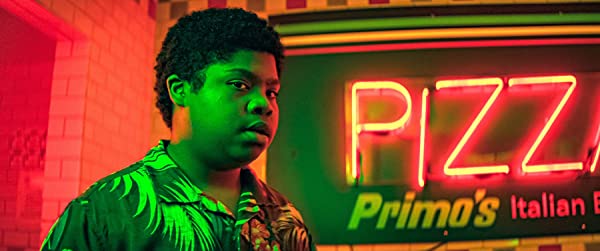Fear Street: Part 3 – 1666: A Showstopping Finale
Fear Street Is A Spectacular Trilogy Worth Seeing
If you’re reading this review of Fear Street: Part 3 – 1666 because you wanted to know if you should watch the whole trilogy, I’ll give you your answer:
Yes.
You absolutely should watch them; see them in order. My previous positive statements didn’t give the movies enough credit, and 1666 retroactively improves 1978. This review is going to be full of spoilers going forward.
For those still here, let’s talk about the ending of Fear Street.


This Is A Series of Clever And Sharp Misdirection
The biggest hint of a hidden fourth movie was that 1666 moved at a blistering pace—too quick for the runtime. It comes and it goes with a hammer blow of a narrative.
But let’s look at that narrative—and why it worried me at first. The time shift was so different it felt like it would derail the entire tone of the series. Reusing the old cast, while a clever trick to maintain empathy with familiar faces, also took some acclimation. Some of the accents not being the best didn’t help.
But I should have trusted the creators more than I did. They knew what they were doing. They subverted the entire series’ simple premise. They pull the rug all the way away.
All Of Fear Street Reframes Itself In Mere Moments
It’s such a good twist it elevates even 1978 in my eyes. Those repetitions of the witch’s curse appear to be a deliberate sleight-of-hand. It even catapults the underlying themes of class struggle into overwhelmingly explicit messaging that retroactively informs everything.
But let’s talk about the witch plot of 1666. As my first actual criticism in this article, those beginning bits are the weakest part. I’ve seen the witch hunt, mass hysteria, and resulting victimization of innocent women plot played often. They do it effectively bleak enough and stylish enough, sure. And the message is still poignant as ever. But the scene with the preacher and the eyes (and some fun editing) is the only thing undercutting a mostly standard delivery. The tension’s fine, the pacing is great, but it’s typical horror.
Somehow The Witch Hunt Is The Weakest Aspect
I also question how Sarah Fier cursed the Goode family. She’s not a witch, and the whole point is she has no magic—and was a scapegoat. But it’s a nitpick, and in a world of zombie serial killers, it’s easy to accept ghosts as a general thing. It has to be this way for the plot to hold.
This brings us to the second “half” of the movie—where all that setup coalesces magnificently. The amazing choices just keep coming. The first movie’s convenience store scene already sold me on how fun the multiple killers were, but this takes it to another level. It hadn’t occurred to me to have them fight each other. But once it started, I was cheering. It’s a fantastic scene amongst fantastic scenes. By the time the characters are in the mall, there’s so much going on, so many plot threads moving and twisting simultaneously—and it was full of tension and uncertainty and delightful outcomes.
Fear Street‘s Climax Keeps Hitting Plot Bullseyes
I have only two major complaints about the whole ending, and they’re only letdowns because of how much love and care went into the rest of the writing. As far as I recall, no other time have possessed people been able to fight the possession. It’s a cheap trick to circumvent tension at such an important moment. Having Sam get loose and fight Deena was a spectacular choice, but they could’ve resolved it any other way. Same issue with how Nick Goode loses. Why would Satan’s evil slime cause a negative reaction for him? Deena and others, sure, but Nick works for the Devil.
And, yeah, these are nitpicks. But they’re nitpicks that stand out because of how good everything else is. How much it earns every other ending. Rarely would a horror movie have a happy romance, but it’s warranted here. And if that sequel bait pays off in another movie—well, I’m game to watch and review it.
Can We See More Movie Trilogies Done This Way?
Because Fear Street has been a delight. I’m so glad I watched all these movies. They’re wonderfully gory, surprisingly clever, and a delightful way to modernize an older subgenre. It has likable, understandable, and varied characters and gets how to make a horror movie fun. Sure, it never quite loses the negatives of its heritage, and it has a few low points pacing-wise, but it powers through.
This series is proof you can revitalize old franchises in a great way. It shows the benefits of planning and having faith in an entire trilogy before releasing any of it. I can think of few reasons to not recommend Fear Street, and hope for many more R. L. Stine adaptations.
Possibly Related Posts:
Recent Posts
The Gorge Manages To Have Some Great Scenes
The Gorge is one of the best cosmic horror movies I have ever seen—for the… Read More
The First Snow of Fraggle Rock Is Weird But Cute
The First Snow of Fraggle Rock is super cute, but it’s not what I hoped… Read More
Friday Fiction: It’s Starting to Snow (Part 2)
You waited for this story—and for that, we thank you. And along with that, we… Read More
The Sisters Grimm: An Adorable Fairy Tale Show
The Sisters Grimm is a charming little cartoon that basically succeeds at everything it’s trying… Read More
WondLa And How To Make Sci-Fi Kids Shows
WondLa is what a children’s television series should aspire to be. It’s kid-friendly but doesn’t… Read More
LEGO Star Wars: Rebuild The Galaxy – Pieces of the Past Is Fine Enough
The first issue I have with LEGO Star Wars: Rebuild the Galaxy—Pieces of the Past… Read More
Comments